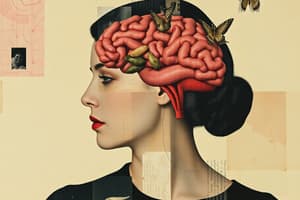Podcast
Questions and Answers
Which factor is associated with family dynamics as a risk for eating disorders?
Which factor is associated with family dynamics as a risk for eating disorders?
- High levels of physical activity
- Low parental involvement
- Difficulty with separation and individuation (correct)
- High family support
What is a significant environmental risk factor for eating disorders?
What is a significant environmental risk factor for eating disorders?
- Stable family environment
- Childhood abuse (correct)
- Healthy peer relationships
- High socioeconomic status
What type of therapy focuses on confronting a client's overvaluation of thinness?
What type of therapy focuses on confronting a client's overvaluation of thinness?
- Behavioral therapy
- Supportive-expressive psychodynamic therapy
- Interpersonal therapy
- Cognitive-behavioral therapy (correct)
Which medication is commonly used to treat symptoms of anorexia?
Which medication is commonly used to treat symptoms of anorexia?
What is a characteristic of interpersonal therapy for eating disorders?
What is a characteristic of interpersonal therapy for eating disorders?
Which treatment method for bulimia focuses on monitoring food intake?
Which treatment method for bulimia focuses on monitoring food intake?
Which of the following statements about reverse anorexia nervosa is true?
Which of the following statements about reverse anorexia nervosa is true?
What is one limitation of using antidepressants in treating eating disorders?
What is one limitation of using antidepressants in treating eating disorders?
What characterizes anorexia nervosa in terms of weight and behavior?
What characterizes anorexia nervosa in terms of weight and behavior?
Which of the following is a type of anorexia nervosa?
Which of the following is a type of anorexia nervosa?
Which of the following statements about bulimia nervosa is true?
Which of the following statements about bulimia nervosa is true?
What distinguishes pica from other feeding disorders?
What distinguishes pica from other feeding disorders?
Which BMI classification indicates a person with severe anorexia nervosa?
Which BMI classification indicates a person with severe anorexia nervosa?
What is a key feature of avoidant/restrictive food intake disorder (ARFID)?
What is a key feature of avoidant/restrictive food intake disorder (ARFID)?
What is the typical age range for the onset of anorexia nervosa?
What is the typical age range for the onset of anorexia nervosa?
What percentage of the general population is expected to develop anorexia nervosa in their lifetime?
What percentage of the general population is expected to develop anorexia nervosa in their lifetime?
Which characteristic is associated with an episode of binge eating?
Which characteristic is associated with an episode of binge eating?
What is the average frequency of inappropriate compensatory behaviors required to diagnose bulimia nervosa?
What is the average frequency of inappropriate compensatory behaviors required to diagnose bulimia nervosa?
Which of the following is NOT a symptom associated with binge eating disorder?
Which of the following is NOT a symptom associated with binge eating disorder?
What differentiates bulimia nervosa from anorexia nervosa regarding preoccupations?
What differentiates bulimia nervosa from anorexia nervosa regarding preoccupations?
Which developmental age range is most commonly associated with the onset of bulimia nervosa?
Which developmental age range is most commonly associated with the onset of bulimia nervosa?
Which of the following statements about binge eating disorder is true?
Which of the following statements about binge eating disorder is true?
What is the classification for individuals with binge eating episodes that occur less than once a week?
What is the classification for individuals with binge eating episodes that occur less than once a week?
What psychosocial factor contributes to the development of eating disorders?
What psychosocial factor contributes to the development of eating disorders?
Which of the following represents a misconception about the prevalence of eating disorders?
Which of the following represents a misconception about the prevalence of eating disorders?
According to the severity ratings of binge eating disorder, how many episodes per week classify as severe?
According to the severity ratings of binge eating disorder, how many episodes per week classify as severe?
What is one common emotional difficulty faced by individuals with eating disorders?
What is one common emotional difficulty faced by individuals with eating disorders?
Which factor is considered a biological contributor to eating disorders?
Which factor is considered a biological contributor to eating disorders?
What emotional state is often associated with binge eating episodes?
What emotional state is often associated with binge eating episodes?
Which statement is true about individuals with bulimia nervosa?
Which statement is true about individuals with bulimia nervosa?
Flashcards
Anorexia Nervosa
Anorexia Nervosa
An eating disorder characterized by a restriction of energy intake leading to significantly low body weight, intense fear of gaining weight, and a disturbance in the way one's body weight or shape is experienced.
Bulimia Nervosa
Bulimia Nervosa
An eating disorder characterized by recurrent episodes of binge eating followed by compensatory behaviors like purging (vomiting, laxatives, etc.) to prevent weight gain.
Binge Eating Disorder
Binge Eating Disorder
An eating disorder characterized by recurrent episodes of binge eating without compensatory behaviors like purging.
Pica
Pica
Signup and view all the flashcards
Rumination Disorder
Rumination Disorder
Signup and view all the flashcards
Avoidant/Restrictive Food Intake Disorder (ARFID)
Avoidant/Restrictive Food Intake Disorder (ARFID)
Signup and view all the flashcards
Anorexia Nervosa - Restricting Type
Anorexia Nervosa - Restricting Type
Signup and view all the flashcards
Anorexia Nervosa - Binge-Eating/Purging Type
Anorexia Nervosa - Binge-Eating/Purging Type
Signup and view all the flashcards
Family dynamics and eating disorders
Family dynamics and eating disorders
Signup and view all the flashcards
Childhood abuse and eating disorders
Childhood abuse and eating disorders
Signup and view all the flashcards
Life stress and eating disorders
Life stress and eating disorders
Signup and view all the flashcards
Reverse anorexia nervosa (muscle dysmorphia)
Reverse anorexia nervosa (muscle dysmorphia)
Signup and view all the flashcards
Cognitive-behavioral therapy for eating disorders
Cognitive-behavioral therapy for eating disorders
Signup and view all the flashcards
Refeeding for anorexia
Refeeding for anorexia
Signup and view all the flashcards
Antidepressants for eating disorders
Antidepressants for eating disorders
Signup and view all the flashcards
Family therapy for anorexia
Family therapy for anorexia
Signup and view all the flashcards
What characterizes a binge-eating episode?
What characterizes a binge-eating episode?
Signup and view all the flashcards
What are inappropriate compensatory behaviors?
What are inappropriate compensatory behaviors?
Signup and view all the flashcards
How often do binge episodes and compensatory behaviors need to happen for Bulimia Nervosa?
How often do binge episodes and compensatory behaviors need to happen for Bulimia Nervosa?
Signup and view all the flashcards
What is the main feature of Bulimia Nervosa?
What is the main feature of Bulimia Nervosa?
Signup and view all the flashcards
How does self-evaluation relate to Bulimia Nervosa?
How does self-evaluation relate to Bulimia Nervosa?
Signup and view all the flashcards
What is the difference between Bulimia Nervosa and Anorexia Nervosa?
What is the difference between Bulimia Nervosa and Anorexia Nervosa?
Signup and view all the flashcards
What is the lifetime prevalence of Bulimia Nervosa?
What is the lifetime prevalence of Bulimia Nervosa?
Signup and view all the flashcards
What is the typical age of onset for Bulimia Nervosa?
What is the typical age of onset for Bulimia Nervosa?
Signup and view all the flashcards
How is Bulimia Nervosa often described in terms of its course?
How is Bulimia Nervosa often described in terms of its course?
Signup and view all the flashcards
What are some common mental health issues associated with Bulimia Nervosa?
What are some common mental health issues associated with Bulimia Nervosa?
Signup and view all the flashcards
What are some similarities between Anorexia Nervosa and Bulimia Nervosa?
What are some similarities between Anorexia Nervosa and Bulimia Nervosa?
Signup and view all the flashcards
What differentiates Bulimia Nervosa from Anorexia Nervosa?
What differentiates Bulimia Nervosa from Anorexia Nervosa?
Signup and view all the flashcards
What is Atypical Anorexia Nervosa?
What is Atypical Anorexia Nervosa?
Signup and view all the flashcards
What is Binge Eating Disorder?
What is Binge Eating Disorder?
Signup and view all the flashcards
What are some cognitive factors associated with eating disorders?
What are some cognitive factors associated with eating disorders?
Signup and view all the flashcards
Study Notes
Feeding and Eating Disorders Overview
- Feeding and eating disorders encompass various conditions, including anorexia nervosa, bulimia nervosa, binge-eating disorder, pica, rumination disorder, and avoidant/restrictive food intake disorder (ARFID).
- DSM-5-TR criteria define specific characteristics for each disorder.
Anorexia Nervosa
- Core Features: Restriction of energy intake relative to requirements, leading to significantly low body weight, intense fear of gaining weight, distorted body image.
- Severity: Classified by BMI (mild, moderate, severe, extreme).
- Types: Restricting type (strictly limiting food), binge-eating/purging type (binge eating followed by purging).
- Epidemiology: Affects approximately 1% of the population, primarily females, typically begins in adolescence (14-18 years). Death rate of 5-9%.
- Genetic predisposition, gender, racial differences may play roles.
Bulimia Nervosa
- Core Features: Recurrent episodes of binge eating (eating significantly more than usual, feeling out of control), followed by inappropriate compensatory behaviors (purging, laxative use, fasting, excessive exercise) to prevent weight gain.
- Frequency: Episodes occur at least once a week for three months.
- Self-Evaluation: Body shape and weight unduly influence self-regard.
- Epidemiology: Lifetime prevalence of 1-1.5% in adults, 0.1-2% in adolescents. Primarily affects females, typically beginning between 15 and 29.
Similarities and Differences Between Anorexia and Bulimia
-
Similarities:*
-
Often begin after a period of dieting.
-
Fear of weight gain.
-
Drive to be thin.
-
Preoccupation with food, weight, and appearance.
-
Anxiety, depression, obsessiveness, perfectionism are common.
-
Increased risk of suicide attempts, and substance abuse.
-
Distorted body perception.
-
Disturbed attitudes towards eating.
-
Differences:*
-
Bulimia is often associated with a focus on pleasing others and having interpersonal relationships, whereas anorexia is often focused on the individual.
-
Bulimia is more likely to involve sexual experience than anorexia.
-
Bulimia often displays traits of personality disorders(particularly borderline personality disorder).
Other Specified Feeding or Eating Disorders
- Partial syndrome eating disorders: Do not meet the full criteria for anorexia or bulimia.
- Atypical anorexia nervosa: All anorexia criteria are met, but weight is within normal range.
- Bulimia nervosa of low frequency/limited duration: Meets bulimia criteria, but episodes are less frequent or shorter-lived.
- Night eating syndrome: Excessive eating at night.
Binge-Eating Disorder
- Core Features: Recurrent episodes of binge eating, similar to bulimia, but without compensatory behaviors.
- Additional Characteristics: Eating rapidly, eating until uncomfortably full, eating when not physically hungry, eating alone due to embarrassment, feeling disgusted or guilty afterward.
- Frequency: Episodes occur at least once a week for three months.
- Typically higher weight range than anorexia or bulimia, affects both genders, but slightly more common in females; frequently linked with depression and anxiety.
Understanding Eating Disorders
-
Biological Factors: Genetic predisposition, hormonal changes (puberty), neurochemical imbalances (e.g., serotonin).
-
Psychodynamic View: (Hilde Bruch) Disturbed mother-child interactions contribute to ego deficiencies and distorted perceptions; effective/ineffective parenting styles are considered relevant.
-
Sociocultural Factors: Social media pressure, thin ideal promotion, body dissatisfaction, social stressors, and competitive athletic environments.
-
Cognitive Factors: Obsessive thoughts, perfectionism, impaired cognitive style, all-or-nothing thinking, and low interoceptive awareness.
-
Psychosocial Factors: Emotion regulation difficulties, maladaptive coping mechanisms.
-
Family Dynamics: Family conflicts, difficulties with separation, high family expressiveness.
-
Environmental factors: Childhood abuse, life stressors, teasing.
-
Multicultural factors: Eating disorders are not limited by ethnicity/race. A variety of factors might contribute to eating disorders. Western society's standards of attractiveness may influence. The methods utilized for weight loss may also determine sex difference.
Treatments for Eating Disorders
-
Anorexia: Refeeding, cognitive-behavioral therapy, and family therapy.
-
Bulimia and Binge-Eating Disorder: Cognitive-behavioral therapy, interpersonal therapy, supportive-expressive psychodynamic therapy, behavioral therapy, and in some cases, pharmacological interventions (antidepressants, possibly antipsychotics).
-
Drugs/biological: Antidepressants and some antipsychotics or obesity/diabetes medications can be important adjuncts, but do not address root causes and may not restore normal eating habits.
Studying That Suits You
Use AI to generate personalized quizzes and flashcards to suit your learning preferences.




